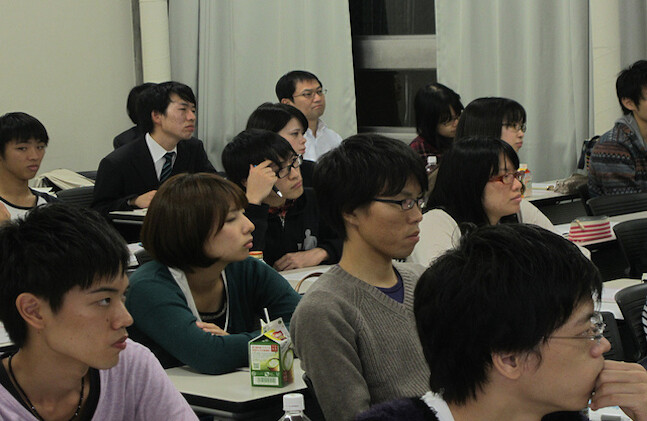Japan has been investing in major reforms to improve its higher education system and therefore its economy. The goal is to foster a new class of globally-minded, creative, and entrepreneurial citizens who can compete with the rest of the world and help reverse Japan's downward slide.
Both productivity and population are falling: In 2014, the country's GDP per hour worked dropped by 0.4 percent. Output per hour was $41.3, compared with $65.2 in France and $64.4 in Germany (though still above South Korea's output of $31). At current trends, Japan's population will fall from 126 million to 107 million by 2050, further burdening social programs and stymying economic recovery. Unless Japan creates radically more open immigration policies, reversing this demographic trend is liable to be very slow.
So instead, Japan has looked to more immediate means of economic recovery, such as expanding labor force participation to include more women and elderly people and boosting productivity through innovation and entrepreneurship. Higher education therefore appears a sensible area from which to promote economic growth, but only if it can truly address the weaknesses of the current system.
Challenges Facing Higher Education
Higher education in Japan is broadly accessible, but at the cost of quality. At 68 percent, Japan boasts the highest first-time tertiary graduation rate among OECD countries, excluding international students. Yet this statistic does not reveal the standard of education students receive. Typically, Japanese universities have large class sizes, vague grading systems, and no reading assignments. According to a 2008 study by Benesse Educational Research and Development Institute, about 81 percent of students spent less than three hours per week studying outside of class, which included 32 percent who said they spent no time studying.
Thus today's higher education is no guarantee of innovation, creative thinking, or global outlook among graduates; but Japan sees potential for positive change. Any proposed reforms, however, must address three major challenges facing higher education.
First, Japan's limited spending on higher education has yielded a heavily privatized system. In 2012, Japan spent 1.8 percent of its public funds on tertiary education, whereas Germany and the UK each spent 3 percent, South Korea 2.6 percent, and France 2.2 percent. The result is an inequitable system which the government has little authority to regulate. Seventy-nine percent of higher education institutions in Japan are private, including universities, junior colleges, and technical schools, and depend on tuition to support their programs. On the other hand, national and public universities receive about 45 percent of their funds from the government, and therefore are able to offer lower tuition, fund more research, and attract more students and faculty. Given this advantage, these universities draw more competition and carry more prestige than their private counterparts.
Second, admissions pools are shrinking. Since the 1990s, the population of 18-year-olds fell by nearly half, from 2.05 million to 1.18 million. Except for a few elite universities, competition in admissions is falling. Private institutions especially face a catch-22 as they try to remain attractive to prospective students but struggle with dwindling budgets.
Third, higher education is outpacing the college-ready population—that is, supply exceeds demand. During the same period that the 18-year-old population halved, the number of universities grew by more than 50 percent, from about 500 to 780. In 2012, education minister Makiko Tanaka denied accreditation to three universities to counter this surplus, but was pressured to reverse this decision a week later. As the population ages, Japan requires a sufficient number of institutions to accommodate the increase in amakudari, or bureaucrats who assume designated posts after retirement, such as board memberships, administrative positions, or teaching jobs. Still, in recent years some universities have fallen prey to market forces; they have been forced to close their application processes and ultimately shut down.
Current Path to more "Global" Education
Through funding initiatives such as the Global 30 Project and Top Global University project, Japan envisions "global universities" to rival institutions worldwide. From 2009 to 2014, the Global 30 Project funded 13 universities to promote more international exchanges. The universities established partnerships with universities in other countries, offered class instruction in English, provided more financial support to international students, and encouraged study abroad among Japanese students. In 2014, the Top Global University succeeded the Global 30 Project by funding more programmatic changes in 37 universities for the next 10 years. Some changes proposed by applicants included hiring more international instructors, attracting more international students, offering courses in languages other than Japanese, and encouraging diverse research and work environments.
By 2020, Japan hopes to nearly double its international exchange flows, to increase the intake of international students from 150,000 to 300,000 and the number of Japanese students abroad from 70,000 to 120,000. The results so far have been positive but fall short of expectations. On one hand, inbound flows of foreign students continue to climb higher than ever before in Japan's history, but with about 93 percent of students from neighboring countries in Asia (mostly China, Vietnam, and South Korea), Japanese universities are not so much global as they are regional at best. This positive trend may also be a result of private institutions compensating for dwindling domestic admissions pools. On the other hand, outbound education is on the rise. In 2013, 70,000 Japanese students were studying abroad, marking a significant recovery from a low of 40,000 in 2010. Still shy of Japan's record high of 83,000 students abroad in 2004, this positive trend may eventually meet Japan's target of 120,000 students by 2020.
Though promising, these funding programs help a few, mostly national, universities, and do not address the concerns of hundreds of other higher education institutions reliant on private funds. In effect, the gap between privately and publicly funded universities will widen. But even these initiatives aren't enough for Japanese universities to keep up with regional competitors in Singapore, South Korea, and China. In 2016, the University of Tokyo, once the top university in Asia for three consecutive years, dropped to seventh place in a list of 200 universities on the continent.
Mismatched Expectations between Applicants and Job Market
Another problem is that the Japanese labor market may not be ready to receive more globally-minded graduates. Study abroad experience may benefit students by giving them more skills, confidence, and higher salaries, but employers do not value such experiences very highly in their applicants. The country boasts a low unemployment rate of about 3 percent and a high availability of jobs at 1.34 per applicant, but these numbers belie a shift in labor market expectations. In 2010, despite the downturn from the global economic crisis, one in three new graduate hires quit their job for reasons such as lack of excitement, unpleasant work relationships, marriage or childbirth, low wages, and too many working hours. Prospective employees now are moving away from the traditional model of lifetime employment. In fact, more young people are falling into the "precariat class," working more short-term, often part-time, jobs. In 2013, about one in five adults in their late 20s relied on their parents for a primary source of income. Reforming higher education is not enough. Japan's companies need to respond to the changing ideals of a more global workforce.
Room for Social and Economic Progress
These reforms overlook higher education's potential for social change. Women are more likely to attain higher education than men, but gender representation varies according to the types of programs and areas of study in which students enroll. More women enter short-term programs in junior colleges or vocational schools, which last two to three years. Female representation declines with more advanced programs, such as four-year universities and postgraduate programs. Given this trend, female professors in Japanese universities are scarce.
Women usually specialize in health and welfare services, education, and humanities, while men pursue engineering and social sciences. Although female representation in sciences and engineering is typically low worldwide—around 20-30 percent—Japan ranks at the bottom of OECD countries, with 15 percent female representation of entrants in such bachelor's programs. Japanese women in science perform better than their male counterparts and secure jobs more easily after graduation, but female researchers generally feel unwelcome in their workplaces and often choose to take their research overseas—an unfortunate brain drain for a country in search of innovation. In 2014, more than 60 percent of Japanese researchers abroad were women.
Abe's "Womenomics" program aims to bring more women into the labor force but fails to acknowledge the gender gaps in higher education which continue into the job market. If Japan can address these disparities and capture the outward flow of talent from its economy, it may have a better chance of achieving the recovery it seeks.
Race to the Top or Bottom?
The Ministry of Education has rated these reforms positively, but some critics believe Japan is on a misguided path of "dumbing down" its higher education programs, especially after the ministry issued an order which implied the abolishment of liberal arts departments from all national universities. In response to public uproar, the ministry issued a press release clarifying their intention to close teacher training programs which do not focus on attaining teaching certifications. Still, these public criticisms indicate a general belief that the government values economic benefits by any means.
These reform programs are an attempt to break from the past, but Japan's failure to acknowledge the nuanced challenges of higher education and its heavy focus on numbers may instead expedite Japan's race to the bottom in higher education. For instance, the Global 30 Project was named for its target of attracting 300,000 international students (so named because 300,000 is written as 30万 or 30 multiplied by 10,000). Although a minor detail, this obscure name for a global initiative is emblematic of Japan's inability to look outward despite its best intentions.
By some measures, Japan may achieve what it sets out to do—to adopt global curricula in multiple languages, increase study abroad participation rates, and take on diverse research projects—but probably only in its best schools. These reform programs ignore the funding issues that beset private universities, changing expectations in the labor market, and persistent gender gaps across higher education programs and departments. Indeed, higher education can serve a pivotal role in recovering Japan's global competitiveness, but "globalizing" only its best and brightest may not be enough.




